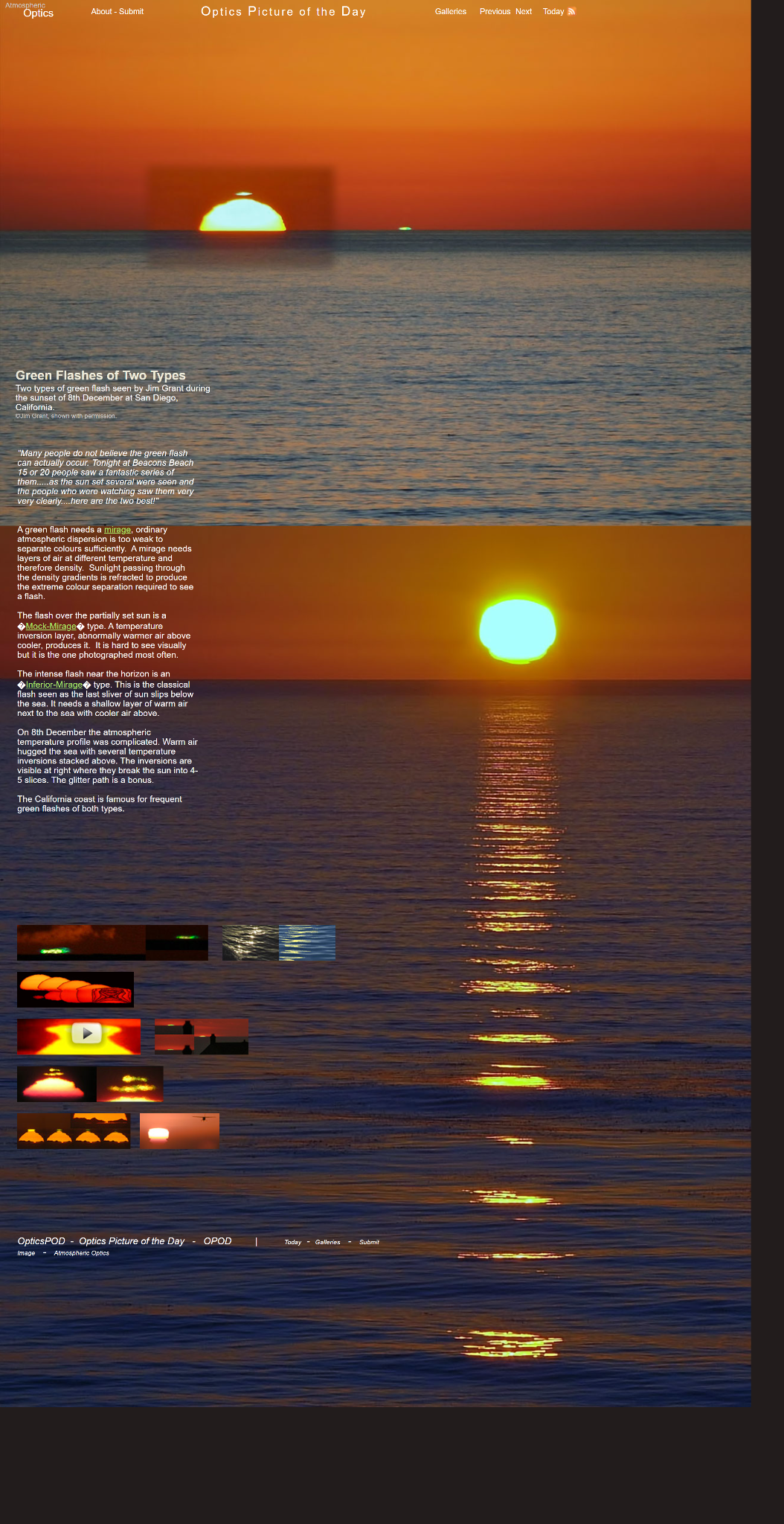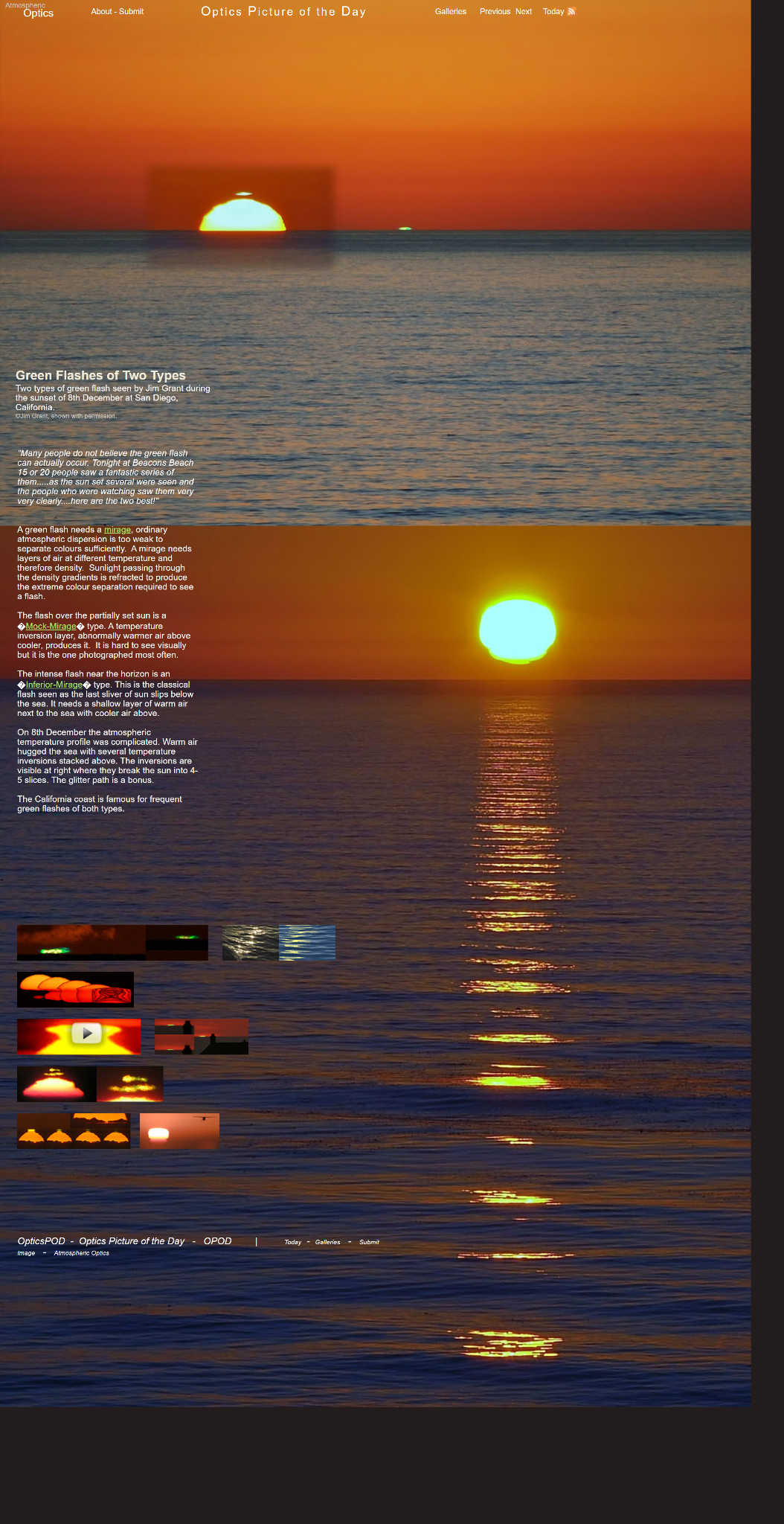OPOD - 2 kinds of green flash
OPOD - Two Kinds of Green Flash: Exploring the Phenomenon in Detail
Green flashes, a breathtaking optical phenomenon, captivate the imagination of many. They are often regarded as elusive and mythical occurrences, but in reality, they can be observed under specific atmospheric conditions. In this article, we delve deeper into the topic of green flashes, focusing on the two types observed by Jim Grant during a stunning sunset on December 8th in San Diego, California.
A green flash requires a mirage to manifest. Ordinary atmospheric dispersion is insufficient to separate colors adequately. A mirage necessitates the presence of layers of air with varying temperatures and densities. As sunlight passes through these density gradients, it undergoes refraction, resulting in the extreme color separation that is essential for perceiving a green flash.
One type of green flash observed by Grant is known as the "Mock-Mirage" flash. It occurs when a temperature inversion layer, where abnormally warmer air lies above cooler air, forms. Although visually challenging to discern, this type is frequently captured in photographs. The phenomenon manifests itself over the partially set sun.
The other type of green flash witnessed near the horizon is referred to as the "Inferior-Mirage" flash. This classic green flash is observed as the last sliver of the sun slips below the sea. It requires a shallow layer of warm air adjacent to the sea, with cooler air above.
On December 8th, the atmospheric temperature profile in San Diego was intricate. Warm air enveloped the sea, with multiple temperature inversions stacked above it. These inversions are visible on the right side of the photograph, where they appear as breaks in the sun, forming 4-5 distinct slices. As a bonus, the glitter path adds an enchanting touch to the scene.
The California coast has gained renown for its frequent occurrences of both types of green flashes. These captivating displays of nature's artistry have fascinated observers for years. While some may remain skeptical of their existence, the experiences of Grant and the numerous witnesses at Beacons Beach on that eventful evening serve as a testament to the reality of green flashes.
In conclusion, green flashes are awe-inspiring optical phenomena that occur under specific atmospheric conditions. They require the presence of mirages, which in turn rely on temperature inversions and density gradients within the air. The two types of green flashes observed by Jim Grant during the December 8th sunset in San Diego, California, provide valuable insights into the intricacies of this natural spectacle. Whether it be the "Mock-Mirage" flash or the "Inferior-Mirage" flash, both types showcase the beauty and complexity of atmospheric optics. So, the next time you find yourself gazing at a mesmerizing sunset, keep your eyes peeled for the possibility of witnessing a green flash, a momentary burst of vivid color that will leave you in awe of the wonders of our atmosphere.

Green Flashes of Two Types
Two types of green flash seen by Jim Grant during the sunset of 8th December at San Diego, California.
©Jim Grant, shown with permission.
"Many people do not believe the green flash can actually occur. Tonight at Beacons Beach 15 or 20 people saw a fantastic series of them.....as the sun set several were seen and the people who were watching saw them very very clearly....here are the two best!"
A green flash needs a mirage, ordinary atmospheric dispersion is too weak to separate colours sufficiently. A mirage needs layers of air at different temperature and therefore density. Sunlight passing through the density gradients is refracted to produce the extreme colour separation required to see a flash.
The flash over the partially set sun is a �Mock-Mirage� type. A temperature inversion layer, abnormally warmer air above cooler, produces it. It is hard to see visually but it is the one photographed most often.
The intense flash near the horizon is an �Inferior-Mirage� type. This is the classical flash seen as the last sliver of sun slips below the sea. It needs a shallow layer of warm air next to the sea with cooler air above.
On 8th December the atmospheric temperature profile was complicated. Warm air hugged the sea with several temperature inversions stacked above. The inversions are visible at right where they break the sun into 4-5 slices. The glitter path is a bonus.
The California coast is famous for frequent green flashes of both types.

Note: this article has been automatically converted from the old site and may not appear as intended. You can find the original article here.
Reference Atmospheric Optics
If you use any of the definitions, information, or data presented on Atmospheric Optics, please copy the link or reference below to properly credit us as the reference source. Thank you!
-
<a href="https://atoptics.co.uk/blog/opod-2-kinds-of-green-flash/">OPOD - 2 kinds of green flash</a>
-
"OPOD - 2 kinds of green flash". Atmospheric Optics. Accessed on November 26, 2024. https://atoptics.co.uk/blog/opod-2-kinds-of-green-flash/.
-
"OPOD - 2 kinds of green flash". Atmospheric Optics, https://atoptics.co.uk/blog/opod-2-kinds-of-green-flash/. Accessed 26 November, 2024
-
OPOD - 2 kinds of green flash. Atmospheric Optics. Retrieved from https://atoptics.co.uk/blog/opod-2-kinds-of-green-flash/.